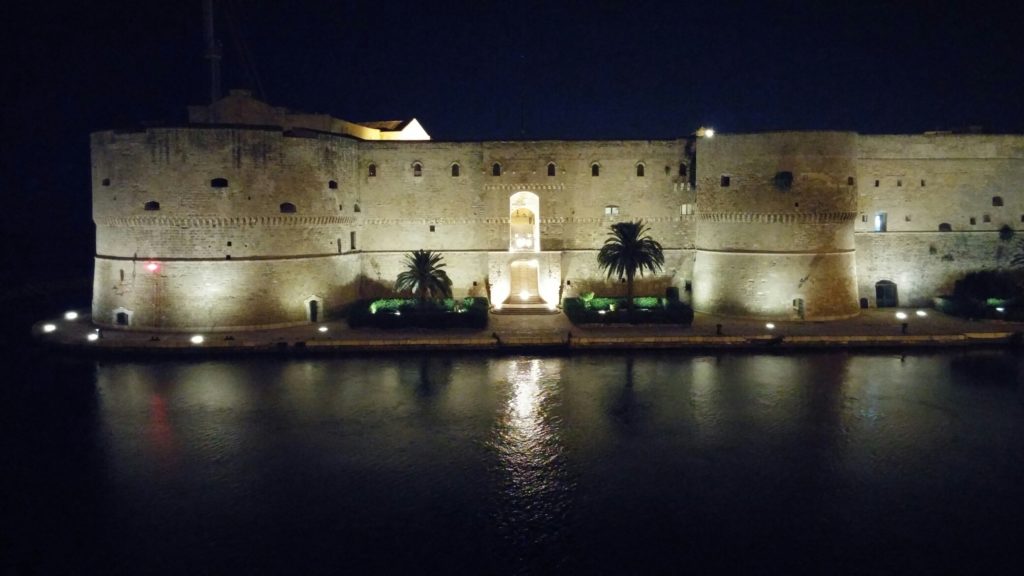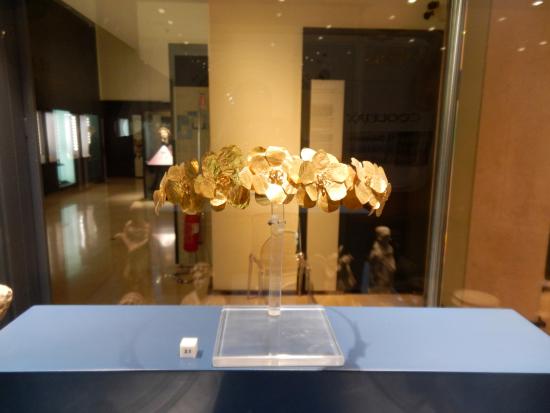To reach the places with a smartphone with active GPS, click inside the maps on “View larger map” and then on “Directions”
Visit Taranto and its treasures (16km from Pulsano)
Taranto is one of the most beautiful and fascinating Italian cities of the coast, capital of the ancient Magna Grecia, it is very rich in points of interest, artistic treasures and evocative places.
To visit all the important places of the city it would take many days, but if the holiday allows less time, we suggest not to lose the following points of interest.

Castello Aragonese (ancient castle) and Ponte Girevole (bridge that opens in two rotating parts)
The Castello Aragonese castle is one of the most beautiful and fascinating castles in Italy, it almost seems to float on the water.
The bridge opens in two rotating parts and is probably unique in the world. It is very nice to see it when it opens at the scheduled times.
On the Castello Aragonese official website http://www.castelloaragonesetaranto.com there is a virtual tour on its four levels, just to give you an idea of the extraordinary nature of the place.
Do not miss the evening visits: http://www.castelloaragonesetaranto.com/orari.
Information office phone: 0997753438 – Email: infocastelloaragonese@libero.it


Taranto – evening tour by car
Evening tour by car around the old town and walk along the promenade.
An opportunity not to be missed in the evening is one (or more) car tours around the old town. In the Google map at the bottom you just get to the bottom of Corso Umberto road, cross the Pounte Girevole (bridge), and turn around the island and then return to the beautiful promenade of the new centre town (there are parking spaces along the way). In the evening we suggest a short walk from the Castello Aragonese (castle) to the first part of the port, on the right and back along the seafront, from the Ponte Girevole to the impressive Fascist Government Palace.



Shopping streets
The streets of Via Palma and Via d’Acquino are certainly of interest to tourists due to the presence of the most beautiful shops in the city. To unite the two streets there is the beautiful Piazza Maria Immacolata square.


Boat trip
With a boat ride you can catch all the charm and character of this ancient city of the coast.
https://www.tripadvisor.it/Attraction_Review-g187878-d6784330-Reviews-Cala_Junco_Boat_Tours-Taranto_Province_of_Taranto_Puglia.html




Museum of the ancient gold jewelry of Taranto
Surely one of the most famous museums of ancient gold jewelry in the world. A small part of the ancient jewels and terracottas of Taranto has been exhibited in the most important museums in the world. Just to name a couple, the Metropolitan Museum of Art in New York and the British Museum in London. Why not take advantage to see the whole collection? http://www.museotaranto.beniculturali.it




Ancient church of San Domenico Maggiore in the the Città Vecchia (old centre town)
In the ancient town centre of this extraordinary and suggestive Romanesque style church (with Gothic and Baroque elements), stood a Greek temple from the Archaic period, later rebuilt in the classical era (5th century BC). On its ruins, in the course of the XI century, the church of San Pietro Imperiale was built, in Byzantine style, with an adjoining convent. The complex was abandoned by the Benedictines in the year 1228.
As evidenced by an inscription in Latin in the emblem of the entrance portal, the current building was built in the year 1302 and dedicated to San Domenico by Giovanni Taurisano.



Basilica and Cathedral of San Cataldo in the Città Vecchia (old centre town)
Among the most beautiful churches in the entire region, the Cathedral Basilica dedicated to San Cataldo is the flagship of the Città Vecchia (old centre town), in Piazza Duomo. Of medieval origin, but modified in the Baroque period, it preserves the remains of the saint in a side chapel.
The eighteenth-century façade is a baroque triumph, between niches of saints, angels and medallions, a prelude to the sumptuous interior of 84 meters in length, where the three naves and numerous chapels open up. The big chapel di San Cataldo preserves the remains of the saint and is surrounded by marbles and stuccos. To experience a certain Byzantine suggestion, we recommend visiting the cruciform crypt (placed under the high altar), supported by low columns and decorated with 13th-century frescoes.



Church of Maria SS del Carmine
The Chiesa del Carmine of the new town centre of Taranto is one of the most important church for the city because it is the seat of the ancient congregation of Carmine dating back to 1500 and is fundamental for the rites of the Holy Tarantine week. The church, built around the year 1577, has been modified several times over the centuries, until it assumes the current appearance in neoclassical style. In the church is preserved a column that was part of the first church where San Pietro, passing through Taranto, would have celebrated a function in the church located where now there is the canal (the column was found during the excavations of the canal itself).



Concathedral Gran Madre di Dio
From the earliest past, we take us to the early sixties, when the Archbishop of Taranto, Monsignor Guglielmo Motolese, entrusted the famous architect Gio Ponti with the task of designing a modern co-cathedral in the new part of the city. The cathedral is not only one of the greatest expressions of Italian architecture and design of the twentieth century but is also one of the few to convey such a profound spiritual charge.
Gio Ponti described his project in this way: “I thought: two sides. One, the younger one, climbing the staircase, with the doors to access the church. The other, the largest, accessible only to the eye and the wind: a facade for the air, with eighty windows open on the immense, which is the dimension of mystery”.
The sail, 53 meters high above the church, summons the outside and is reflected and multiplied outside, in the water mirrors in front: composed of two thin parallel walls, perforated, one to one meter from the other, on which light plays, it is an architectural acrobatics, a mixture of concreteness and air dedicated to heaven. (quoted by Luigi Moretti)


